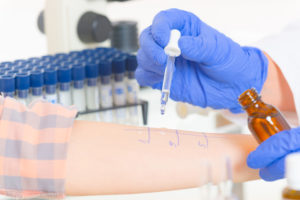 Sure Dr. Kronberg performs all kind of fancy skin treatments such as laser skin tightening, addressing double chins with Kybella, microdermabrasion, and strategic use of dermal fillers. But she also provides all of the needs of general dermatology. One of those is finding out exactly what you may be allergic to. She plays the role of detective here and uses patch testing as her trusty sidekick.
Sure Dr. Kronberg performs all kind of fancy skin treatments such as laser skin tightening, addressing double chins with Kybella, microdermabrasion, and strategic use of dermal fillers. But she also provides all of the needs of general dermatology. One of those is finding out exactly what you may be allergic to. She plays the role of detective here and uses patch testing as her trusty sidekick.
Have you ever come in contact with something — maybe it’s a cleaning product, maybe a new cosmetic, maybe it’s some metal — and the next thing you know you have a red, inflamed, itchy patch of skin that soon turns scaly?
While you may not think of this as the same thing as the sneezing and watery eyes that come with allergies, it is similar. You’ve had allergic contact dermatitis (ACD), a skin condition where you develop patches of eczema (clinically known as dermatitis) as a response to a specific substance.
What’s responsible? Your immune system. Your body has come in contact with a particular substance and reacted by calling out the cavalry, sending histamines into the blood to combat the intruder. Although the histamines’ aim is true, in excess they can inadvertently cause swelling and itching of the skin, in this case allergic contact dermatitis. They also cause the sneezing and other issues with typical allergies such as hayfever.
That’s where Dr. Kronberg must find the culprit behind the allergic reaction. For this, she uses patch testing.
What is patch testing?
Patch testing is a procedure used to identity the external substances that cause a person’s allergies. In cases of contact dermatitis this can be very helpful, as the patient then knows what substances or things to avoid. Patch testing for common allergies (tree pollen, for instance) is not as effective, as avoidance is almost impossible when the plant is blooming.
While some people know they are allergic to something, say shellfish, others have no idea. They buy a new brand of makeup, a new skin cream, and the next thing they know they have a patch of inflamed, itchy skin. Patch testing can tell the person what in the new product is causing their reaction, so they no longer buy or use the product.
What cultprits does Dr. Kronberg test for?
Our patch tests include the most common substances that may be triggering your ACD. Many of these substances may not be recognizable by name, but are found in additives to clothes, leather, ointments, and other common products. Dr. Kronberg tests for these items:
- Cobalt
- Epoxy resin
- Balsam of Peru
- Ethylenediamine
- Formaldehyde
- Neomycin
- Paraben mix
- Plants
- Formaldehyde resin
- Wool alcohols (lanolin)
- Quaternium-15
- Nickel
- Fragrances
- Clioquinol
- Rubber accelerators
If there are other possibilities such as common things you come across at work, they can be added to your patch.
Once your patch results come back, we can tell you the items, ingredients, or chemicals to watch out for on product labels and such.
Do you have ACD at times? Call Dr. Kronberg; she’ll get to the bottom of your problem with patch testing. Call 713-771-8941 to make an appointment.





No comments yet.